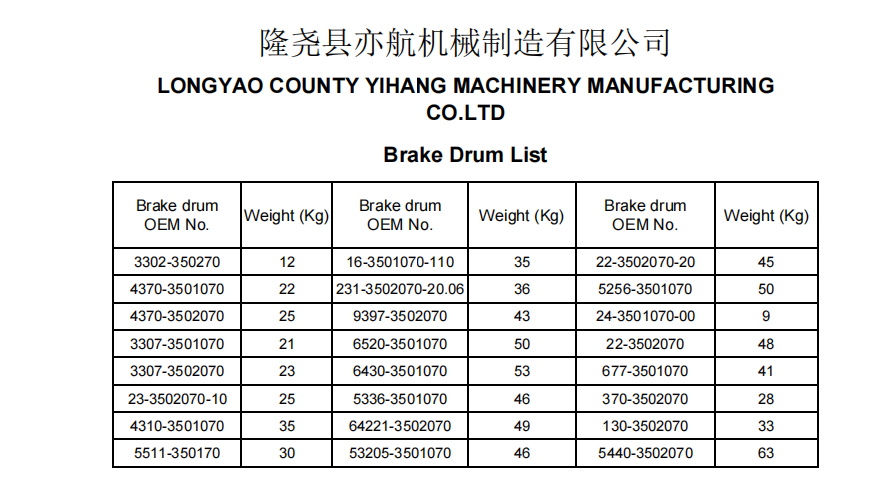Dec . 01, 2024 06:41 Back to list
How to Release Stuck Rear Brake Drums Effectively and Safely
Removing Stuck Rear Brake Drums A Step-by-Step Guide
Removing stuck rear brake drums can be a challenging task for both amateur and experienced mechanics. Brake drums can seize due to corrosion, dust accumulation, or improper adjustment of the brake components. If you find yourself facing this problem, fear not. This article will guide you through a systematic approach to safely detach those stubborn brake drums, ensuring you get your vehicle back on the road effectively and efficiently.
Understanding Brake Drums
Before proceeding, it’s essential to understand the components involved in a drum brake system. Brake drums are circular components that house the brake shoes. When you apply the brakes, hydraulic fluid pushes the shoes outward against the inner surface of the drum, creating friction that slows or stops the vehicle. Over time, moisture and contaminants can lead to rust, making the drums difficult to remove.
Tools You Will Need
To begin the removal process, gather the following tools
1. Jack and Jack Stands To lift the rear of the vehicle safely. 2. Lug Wrench To remove the wheel lug nuts. 3. Brake Drum Puller A specialized tool designed to grip and pull the drum free. 4. Hammer A rubber mallet is preferable to avoid damaging the drum. 5. Penetrating Oil Such as WD-40, to loosen rust. 6. C-clamp To compress the brake shoes if needed. 7. Safety Goggles and Gloves For personal protection.
Step-by-Step Removal Process
1. Prepare the Vehicle
Start by ensuring the vehicle is parked on a flat surface and put in gear or set the parking brake. Loosen the lug nuts slightly while the wheel is still on the ground, making this step easier once the vehicle is lifted.
2. Raise the Vehicle
Using the jack, lift the rear of the vehicle and securely place jack stands under it. Ensure the vehicle is stable before you begin working.
3. Remove the Wheels
With the lug nuts loosened earlier, remove them completely and take off the rear wheels to expose the brake drums
.removing stuck rear brake drums

4. Inspect the Drums
Before attempting removal, inspect the drums for visible signs of damage or wear. Make sure to check around the edges for rust or any obstructions.
5. Apply Penetrating Oil
Spray penetrating oil around the base of the brake drum where it meets the axle hub. Let it sit for several minutes to loosen any corrosion that may be causing the drum to stick.
6. Strike the Drum
Using a rubber mallet, gently tap around the outer edges of the drum. This shock can help break the rust bond. Be cautious not to hit too hard as this can damage the drum.
7. Use a Brake Drum Puller
If tapping does not yield results, insert the brake drum puller. Position it according to the manufacturer’s instructions, ensuring it grips properly on the drum. Gradually tighten the puller’s central bolt to apply consistent pressure, which should help pry the drum off.
8. Check Brake Adjustments
If the drum still does not budge, check for brake shoe adjustment. Many drum brakes have an adjusting mechanism that, if improperly set, can cause the shoes to bind against the drum. Use a C-clamp to compress the shoes slightly, and adjust the self-adjuster until there’s enough clearance.
9. Remove the Drum
Once you’ve either loosened the drum with the puller or adjusted the shoe, pull the drum straight off. Watch for any parts that may fall during removal and handle them safely.
Conclusion
Removing stuck rear brake drums can be a time-consuming process, but with the right tools and a bit of patience, it can be accomplished. Always remember to prioritize safety by wearing protective gear and ensuring the vehicle is secure while you work. If, after several attempts, the drum remains stubbornly attached, consider consulting a professional mechanic. They’ll have additional tools and expertise to help you safely resolve the issue. Regular maintenance of brake components is also key to preventing future sieges, so make it a habit to inspect and clean your brake system periodically. Happy wrenching!
-
Scania Brake Drums: OEM Quality for Optimal Safety & Durability
NewsAug.16,2025
-
R.V.I: Advanced Remote Visual Inspection for Precision
NewsAug.15,2025
-
Discover HYUNDA: Innovative Vehicles, Equipment & Solutions
NewsAug.14,2025
-
R.V.I: Unlock Advanced Insights & Real-time Performance
NewsAug.13,2025
-
Kamaz Brake Drum: Durable & Reliable for Heavy Duty Trucks
NewsAug.12,2025
-
Heavy Duty Iveco Brake Drum - Premium Quality & Safety
NewsAug.11,2025
